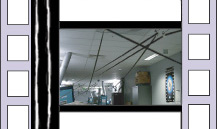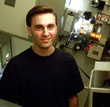|
|
This topic comprises 2 pages: 1 2
|
|
Author
|
Topic: Horizontal line
|
Michael Brown
Phenomenal Film Handler

Posts: 1522
From: Bradford, England
Registered: May 2001
|
 posted 06-17-2001 11:28 AM
posted 06-17-2001 11:28 AM




Okay, this happened last night at the cinema I spoke about in the post below.I was watching Along came a Spider (Scope) and noticed that whenever there was a cut a black horizontal line would flash up across the length of the bottom of the screen. It was as if the frame line was "jumping up" eact time there was a cut in the image. If anybody has any ideas, it was unusuall. ------------------
------------------
Michael Brown
Bradford Student Cinema
www.bradfordstudentcinema.co.uk
| IP: Logged
|
|
|
|
|
|
Leo Enticknap
Film God

Posts: 7474
From: Loma Linda, CA
Registered: Jul 2000
|
 posted 06-18-2001 06:52 AM
posted 06-18-2001 06:52 AM





If it were a neg splice, then surely the horizontal line would be white, not black? As in...cut camera negative (splice forms opaque line) THEN fine grain pos (negative image of splice shows as clear line) THEN dupe neg (reversed, i.e. opaque again) THEN release print (reversed, i.e. clear again). So if a neg splice were showing, I'd expect to see a white flash rather than a black line. But as it happened on every cut, I guess it can't be a lab join. So was this production shot on reversal stock or am I missing something?
| IP: Logged
|
|
|
|
John Pytlak
Film God

Posts: 9987
From: Rochester, NY 14650-1922
Registered: Jan 2000
|
 posted 06-20-2001 10:31 AM
posted 06-20-2001 10:31 AM





The "flashes" at scene changes are likely the negative splices. SMPTE Recommended Practice RP 111 specifies the dimensions of the splices, including the overlap. The cement negative splicers developed for the original "CinemaScope" format had a very narrow overlap so as not to show on the projected image. But the narrow overlap was less reliable, leading to the use of splicers having more overlap but more risk of the splice being seen. Because of this, the anamorphic image height has been reduced from 0.715 to 0.700 to 0.690 inches over time. Yet some splicers (or splicing techniques) produce negative splices tha still may project with the current 0.825 x 0.690 inch anamorphic image area, unless perfectly framed.Here is the history I provided to Marty Hart's American Widescreen Museum website: _____________________________________________________________________
From 1957 through today, there have been a number of small changes to the anamorphic projector aperture recommended standards.
John P. Pytlak of Eastman Kodak dug through countless back issues of the SMPTE Journal in order to provide the following chronology
of the changes to the standards: The March 1957 SMPTE Journal has PH22.104-1957, the standard for 2.55:1 anamorphic (no optical track), with an aperture size of
0.912 X 0.715 inches. Notice of withdrawal of this standard was in the January 1964 Journal. The December 1957 SMPTE Journal has PH22.106-1957 for 2.35:1 anamorphic, with an aperture of 0.839 X 0.715 inches. It was
unchanged in the September 1964 Journal. The November 1965 SMPTE Journal published PH22.106-1965 still with the 0.839 X 0.715
aperture size. In the September 1970 SMPTE Journal, a new draft of PH22.106 was proposed, with an aperture size of 0.838 X 0.700 inches, to
minimize the flashes at splices. This was republished as standard PH22.106-1971 in the October 1971 issue. In the June 1976 SMPTE Journal, the two (flat and scope) projectable image area standards (PH22.58 and PH22.106) were
consolidated into one standard and renamed PH22.195. The publication of PH22.195-1984 in the October 1984 Journal still had the
scope area as 0.700 X 0.838 inches. The June 1992 SMPTE Journal published a proposed revision, with a scope area of 0.690 X 0.825 inches. In August 1993, the
standard was published as SMPTE 195-1993, with the current area of 0.690 X 0.825 inches. So August 1993 is when the two formats
became the same width of 0.825 inches.
______________________________________________________________________
http://www.widescreenmuseum.com/widescreen/apertures.htm ------------------
John P. Pytlak, Senior Technical Specialist
Worldwide Technical Services, Entertainment Imaging
Eastman Kodak Company
Research Labs, Building 69, Room 7419
Rochester, New York, 14650-1922 USA
Tel: 716-477-5325 Cell: 716-781-4036 Fax: 716-722-7243
E-Mail: john.pytlak@kodak.com
Web site: http://www.kodak.com/go/motion
| IP: Logged
|
|
|
|
|
|
|
|
John Pytlak
Film God

Posts: 9987
From: Rochester, NY 14650-1922
Registered: Jan 2000
|
 posted 06-21-2001 12:03 PM
posted 06-21-2001 12:03 PM





Standard SMPTE 195 specifies that the image height on a "hard matted" print be at least 0.505 inches (12.83mm), so the picture should be able to be framed without showing the black framelines even with a 1.66:1 aperture (0.825 x 0.497 inches, 20.96 x 12.62 mm). The 1.85:1 aspect ratio has a 0.825 x 0.446 inch (20.96 x 11.33 mm) projectable image area.Perhaps the theatre was mistakingly using an "Academy" 1.37:1 image area (0.825 x 0.602 inches, 20.96 x 15.29 mm)? ------------------
John P. Pytlak, Senior Technical Specialist
Worldwide Technical Services, Entertainment Imaging
Eastman Kodak Company
Research Labs, Building 69, Room 7419
Rochester, New York, 14650-1922 USA
Tel: 716-477-5325 Cell: 716-781-4036 Fax: 716-722-7243
E-Mail: john.pytlak@kodak.com
Web site: http://www.kodak.com/go/motion
| IP: Logged
|
|
Brad Miller
Administrator

Posts: 17775
From: Plano, TX (36.2 miles NW of Rockwall)
Registered: May 99
|
 posted 06-21-2001 02:42 PM
posted 06-21-2001 02:42 PM




This is a basic sketch (courtesy of Joe) showing what I wish 1.85 films would be printed like.  The black would give just enough padding to prevent aperture shadows from appearing and the clear areas would make it virtually impossible to exhibit the film to an audience without the customers raising all hell to the managers to get it framed correctly. The clear frame lines could even have black lettering that says "THIS FILM IS NOT BEING PROPERLY FRAMED - PLEASE CONTACT THE MANAGER". It seems like cheap insurance for 1.85 filmmakers to ensure that their films are being presented in frame. Even if only the first reel of each movie was matted in this way it would pretty much solve most problems (not counting misframes within the print and changeover setups).
| IP: Logged
|
|
|
|
|
|
|
|
|
|
|
|
All times are Central (GMT -6:00)
|
This topic comprises 2 pages: 1 2
|
Powered by Infopop Corporation
UBB.classicTM
6.3.1.2
The Film-Tech Forums are designed for various members related to the cinema industry to express their opinions, viewpoints and testimonials on various products, services and events based upon speculation, personal knowledge and factual information through use, therefore all views represented here allow no liability upon the publishers of this web site and the owners of said views assume no liability for any ill will resulting from these postings. The posts made here are for educational as well as entertainment purposes and as such anyone viewing this portion of the website must accept these views as statements of the author of that opinion
and agrees to release the authors from any and all liability.
|

 Home
Home
 Products
Products
 Store
Store
 Forum
Forum
 Warehouse
Warehouse
 Contact Us
Contact Us




 Printer-friendly view of this topic
Printer-friendly view of this topic



















